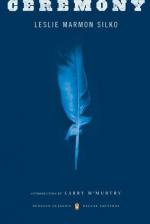|
This section contains 1,012 words (approx. 3 pages at 400 words per page) |

|
Pueblo Indians
The people of the Anasazi tradition inhabit the area of what is now the Southwestern United States (from Taos, New Mexico, to the Hopi mesas in Arizona). They are named Pueblo, meaning "village Indians" in Spanish. They live in concentrated villages of buildings constructed from adobe local clay, and stone. These buildings are entered from the top floor. The buildings, often reaching to five stories, surround a plaza, with a central kiva-a ceremonial place dug into the ground.
Of these people, the western Keres Tribe inhabits Acoma and Laguna. Acoma, perched atop a 400-foot mesa, has been continuously inhabited since at least 1075 AD. Laguna was established more recently. The Pueblo economy centered on a sophisticated system of dry farming and seed cultivation. The matrilineal culture had its labor division: men farmed and performed the ceremonial dances; women made intricate basketry, exquisite pottery, and built the houses...
|
This section contains 1,012 words (approx. 3 pages at 400 words per page) |

|




